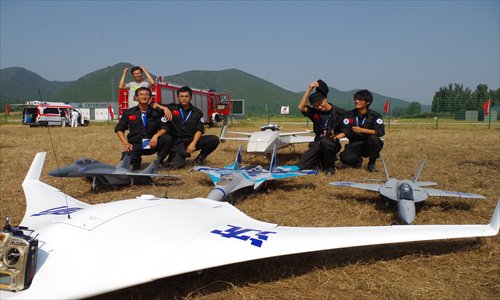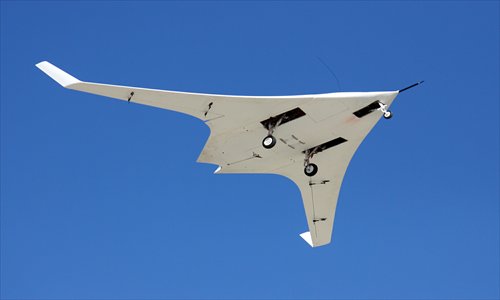Droning On

Liu Yang and his team pose with their drones. Photo: Courtesy of Chen Xiao

The prize-winning UAV that was built by the team at Shenyang Aerospace University. Photo: Courtesy of Chen Xiao
"Three … two … one … start!" As the countdown order was shouted, Liu Yang pressed the Enter key on the keyboard. A white fixed-wing plane took flight. No pilot controlled this craft. It was an unmanned aerial vehicle (UAV), executing the flight path that it had been programmed to follow.
As it cruised and swerved above Miyun Airport, the spectators at the Second AVIC Cup-International UAV Innovation Grand Prix watched, rapt with attention. Finally, the drone descended, attempting to land on the slow-moving mock aircraft carrier in the center of the airfield. As the plane successfully caught the second hook, the audience cheered. Liu Yang and his four teammates, unable to contain their excitement, jumped up and hugged each other.
"We were the first team to achieve that. All the months of hard work paid off," Liu said, referring to the team's joy at winning top prize in the fixed-wing category.
Liu admits that their homemade drone does not meet industry standards for maximum payload or endurance, but maintains that its excellent performance in the mock test "could be very helpful for the resolution of actual tasks and for research on real unmanned planes."
A sophomore at Shenyang Aerospace University in Liaoning Province, Liu said that UAVs are perceived as more "boring" than model airplanes - with good reason. "UAVs are based more on programming and computer-aided control. So sometimes you have to spend days at the computer. But when you finally accomplish it, the sense of satisfaction is also greater," he said.
He Jun, team leader and professor at Shenyang Aerospace University, said that model hobbyists may enjoy flying radio-controlled aircraft, but the process of designing and manufacturing a unmanned plane is truly creative, "Only professionals like us can create the whole system and control it with extreme precision, because we must calculate all the data and design all the control programs."
Unmanned aerial vehicles have been used widely in recent years. According to media reports, UAVs were used to survey the crops hit by rainstorms in Shanxi Province, to spray pesticides in Jiangsu and Hebei provinces, and to monitor the panda reserve in Sichuan Province.
Duan Zhiyong, a coach for the China national model airplane team, still vividly remembers how six drone aircraft were used to support disaster relief for the 2008 Wenchuan earthquake. "On May 14, 2008, we transformed our model airplanes into UAVs by installing autopilots and equipping them with cameras," Duan said. "They took tens of thousands of pictures, real-time visual data that proved invaluable for the relief efforts. Although the planes always ended up damaged upon return, the data was the only thing we were concerned about. After all, there were no people on the plane."
Duan believes that the initiative helped prove the utility of UAVs in
disaster relief and spurred the growth of the industry. "Nowadays, the number of people involved in UAVs in China is 20 times what it was in 2008."
Zhang Juen, executive director of the Chinese Society of Aeronautics
and Astronautics, said that the number of people getting involved in innovation competitions bodes well for the development of UAVs.
"Those control techniques, such as landing on the aircraft carrier, can be put into practice to help supply goods, transport material, and so on," Zhang said, adding that drones unquestionably have advantages over manned planes.
"Because UAVs are unmanned, the space, fuel and payload usually allocated for humans can be reduced. They can also go places that people consider 'dull, dirty, dangerous and difficult.'"